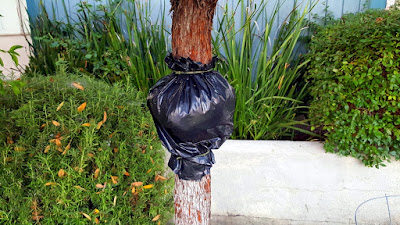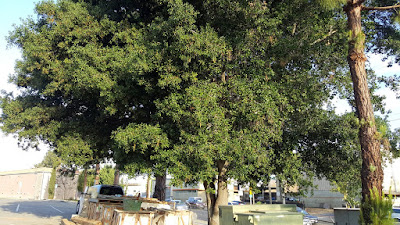Hi everybody, It's me again. Sometimes I write the darnedest things. This is going to be one of those things. Disclaimer: What I am writing is going to be from research and not experience.
However, I have a personal philosophy. I never discard anything even if it goes against my beliefs or is contrary to what I perceive is logical until I feel I have pondered and meditated thoroughly. Why? Because I do not know everything. My understanding of how things work is in flux. Every time I learn something it adds to how I perceive things. Enough with the philosophy.
In the bonsai world, There are those who claim that field grown trees grow thicker trunks quicker than pot grown trees. The idea is that because the trees root system can develop without any constriction than the tree can reach its full potential. Makes sense, if you give a tree the ability to grow its roots and branches to the greatest possible length then its growth should likewise do the same. OK, I get it.
Let me continue by saying that every method of growing bonsai stock has its problems. It's all a question of which one you would rather deal with. The problems you have to deal with when growing field trees is that most people do not have the space to grow a tree's root system to its full potential. Contrary to garden myths, trees do not grow a root mirror image of the canopy. In fact, roots extend far beyond the edge of the canopy. So, if you can not grow a full root system you can not grow a tree as quickly as it otherwise could. But it will grow faster than it does in a pot Ivan, you say. OK, let's say it does. You wait 3-5 years growing this tree. Its trunk is large. You need to fit this trunk and its roots in a relatively small pot. You cut down the branches and start to dig a circle 2-3 feet away from the trunk. You are not removing any dirt. What you are doing is using the shovel to slice off all the roots outside of the 2-3 feet circle. Why? Because the tree needs those roots that you cut off. It took 3-years plus to grow them. The idea is that by cutting off the roots the tree will grow more roots in that 2-3 foot circle. Enough roots to keep it alive when you pull it out of the tree a year later. Yes, even after you cut the roots it will take another year until you can pull the tree out of the ground. And guess what? You can't grow 3 years worth of roots in one year. The tree is at a deficit in root mass.
Of course, growing in pots has its disadvantages. We put bonsai tree in pots to slow down the growth. This happens when we have larger plants in growing pots. Even if you grow a seed in a pot after the third year growth will slow down. Not to mention root bound plants. Normally root bound plants present big problems. Roots that grow in circles or in weird directions are a cause for concern. In bonsai, we prune roots every once I a while. those roots might not be that big of a challenge. However, just like in field grown trees pruning a lot of the roots will cause the plant to slow down its growth.
What are we to do? The answer my friends is blowing in the wind, literally. The answer to this is something that I had seen but did not know what it was for.
Air Pruning, Have you ever seen bonsai growing in colanders? Why would somebody do that? Well here is the idea.
If you grow a tree in a pot the roots will all be watered. The roots will grow like normal. When the roots hit the side of the pot they will start wrapping around the pot. They will grow unchecked in circles.
When you grow a tree in a colander there is air drying out the dirt from every side. When a root grows to the edge it will shrivel and die. There will not be enough moisture to keep the tip of the root alive. The tree will be forced to grow roots from closer to the center of the root mass out. The idea is that because the tree is continually growing roots from the center out it will have a large root mass that will need no pruning, therefore, keeping the growth momentum steady even when transplanted. it's like how we prune trees to build ramification.
Of course, I started my own experiment.
Half of these are Japanese Black Pines and the other are Ponderosa pine. I repotted them in hydroponic baskets. My concern is that the baskets might be too small. I used half fine organics with pumice, coarse sand, and perlite in equal parts.
Two of each pine seedling was placed in the baskets and then placed in a traditional pot. I think that the roots of these will grow out of the baskets.
Cheers.
Update 05/25
As part of the experiment, I potted a couple of trees in the baskets and then slipped them into plastic pots. Tree A is an example of this.
 |
| Nice Trunk on this |
I did that because I figured it would dry much slower in the two pots. This would protect the tips of the roots as they grew out of the pot. Then I would be able to see if there was progress.
 |
| Close Up |
I decided to take a look at this tree's roots. when I removed the outer pot I saw this.
There are actually two roots coming out of the pot. The big one and a smaller one in the back. You can see that the bigger root is already drying out. It is developing a brown spot.
Now, let's look at tree B. It is the same kind of tree California Coastal live oak. It is the same age and about the same size.
I potted these trees in the same soil mix, watered and fertilized the same. same amount of sunlight. All things were equal. yet, there are no roots coming out of this pot or any other of the oaks. Even the cork oak which is still pushing out new leaves has no roots coming out. I would venture to say that the air pruning is working.
Update 06/02/2017
We have a small problem:
This pot was out drying like normal. I picked it up and noticed a moist circle where it was sitting. I turned the pot over and was happy to see the tree growing many roots. Problem is that I need the roots to shrivel up inside the pot. What is the problem? apparently, the bottom of the pot is retaining too much moisture allowing the roots to stay alive.
Solution: I need to raise the pots off of the surface covering as little surface area as possible.
Update 06/15
In my air pruning mania, I potted plants that in hindsight should have not been put in baskets. Here is an example of one:
Here is a close up:
I saw this and thought that maybe it is not wise to air prune plants that make aerial roots like some ficus species. On the plus side, I know that the tree is growing.















































